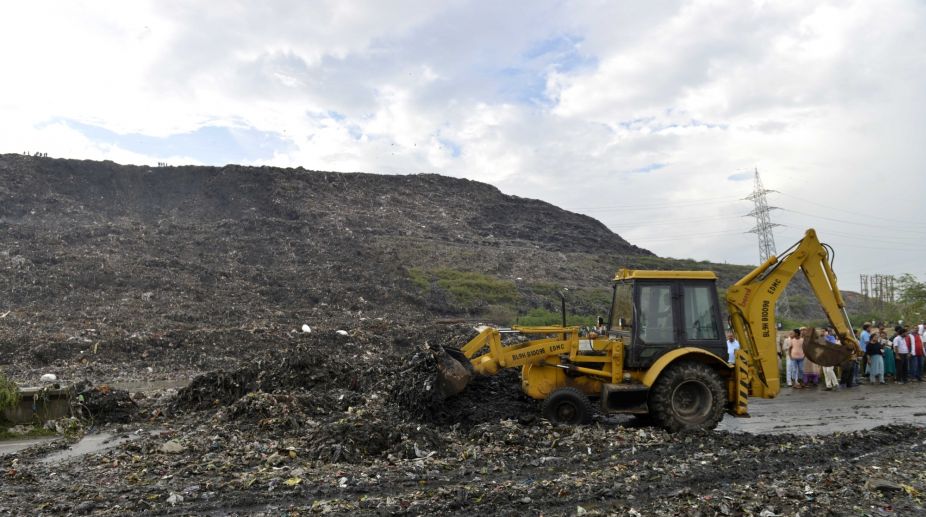Commuters to get info on bus running at stops
Commuters would soon be able to get real-time information on public buses while waiting at bus stops.
The Ghazipur landfill, commissioned in 1984, has long outlived its capacity, but still takes 2500 metric tonnes of garbage daily. The site should have been closed 17 years ago when it crossed its maximum capacity, but still lives on collecting tonnes of waste daily.

Representational image (Photo: IANS)
On the commute from Delhi to Noida while crossing the Ghazipur landfill, you will find no cars with their windows open. The stench of the landfill reaches you before you reach the landfill. The daily reaction of commuters is one of disgust but seems solely limited to the aesthetic depreciation of the site. Is this aesthetic depreciation the only issue with the landfill or is our lens of privilege preventing us from seeing the deeper issues?
The Ghazipur landfill, commissioned in 1984, has long outlived its capacity, but still takes 2500 metric tonnes of garbage daily. The site should have been closed 17 years ago when it crossed its maximum capacity, but still lives on collecting tonnes of waste daily. Right next to the landfill is a residential area. Most of the people living there are Muslims from central Bihar, Bengal or Assam, migrants with few identification documents and fewer rights. These migrants’ only source of livelihood is through this landfill, where they segregate and sell waste to wholesalers. There are about 3,50,000 rag pickers in Delhi, most of whom are connected to the Ghazipur landfill in one way or another. They hope to join the middle class ranks one day – the class that has to bear the stench only for the duration of their commute, not their entire lives.
Advertisement
“Through the year, the site is a constant source of diseases including dengue, malaria, typhoid and respiratory problems,” said Tarannum, a resident of Rajbir colony, located right opposite the landfill site. “I have to live here because rents are cheaper than the rest of the city,” she said in an interview to The Wire, a news portal.
Advertisement
This is where environmentalism of the poor differs from elite environmentalism. The argument for the removal of the Ghazipur landfill, championed by the upper and middle classes, differs from the fight of the minority communities who live near this landfill, face the adverse effects and yet depend on it for their livelihoods. Their struggle is not limited to the aesthetic of the landfill, but instead is one which is deeply linked to social justice.
Similar environmental justice issues emerge with the recent rise of environmental social movements across India. These most prominently feature the Save Mollem campaign in Goa where three developmental projects target the Mollem National Park and the Bhagwan Mahaveer Sanctuary; the Save Thano protests against the expansion of the Jolly Grant Airport in Uttarakhand; the struggle to Save Dumna Nature Park from being converted into a ZoocumTiger Safari in Madhya Pradesh; and the citizens of Gurgaon and Mumbai marching on to save, respectively, the Aravalis from becoming a garbage dump and the Aarey forest from the adverse impacts of installing an underground metro car depot.
These demonstrations have been moderately successful in raising alarm about the government’s rampant drive to industrialize by tearing down India’s forests. The objective of this strategy is to preserve pockets of pristine beauty in their untouched natural glory. It arises from a deep appreciation for the aesthetic joy that natural landscapes, flora and fauna instil in humans.
While preserving some nature, the strategy fails to address the impacts on human society. This form of environmentalism is what Anil Agarwal rebelled against in a pioneering speech in 1985 by saying that environmentalism in India was not just about trees and tigers but about the environmental assets of common people. By struggl ing against industrialization efforts on Adivasi land, the locals become accidental environmentalists. Their struggle does not ar ise from a benign love for the beauty of their land but instead is a struggle for justice, like the communities living beside the Ghazipur landfill. It is related to very material interests: The forest is an essential resource held in common by the people living in it. In the translation of this protest from on-ground and local opposition to upper-class digital advocacy, the element of environmental justice is lost.
The remedies that come out of elite environmentalism do nothing to repair social inequalities. For example, the main solution offered by mainstream environmentalists for the Ghazipur landfill is to shift it to another site. None of the proposed sites affect the upper and middle class settlements, and only affect lower class communities. Shifting the landfill would also lead to the loss of livelihoods of hundreds of people who are dependent on the landfill for their survival. These intersectional issues are completely ignored by elite environmentalists. The real solutions are those offered by marginalized groups who are directly affected by these environmental struggles.
The writers are students at Jindal Global University in Sonipat, Haryana.
Advertisement